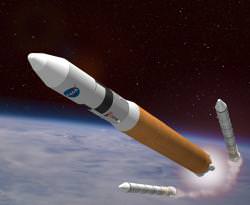 The New York Times is reporting that recent cutbacks to NASA’s budgets will probably push back the human return to the Moon. Instead of retiring the Space Shuttle and sending the first spacecraft back to the Moon in 2014, the first missions won’t be until 2015 instead, according to NASA administrator Michael Griffin.
The New York Times is reporting that recent cutbacks to NASA’s budgets will probably push back the human return to the Moon. Instead of retiring the Space Shuttle and sending the first spacecraft back to the Moon in 2014, the first missions won’t be until 2015 instead, according to NASA administrator Michael Griffin.
Continue reading “NASA Cutbacks Will Delay Moon Missions”
New Engine Could Let Spacecraft Do More with Less Fuel
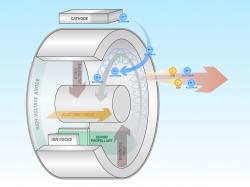 One of the main problems with spacecraft is the cost to get them into orbit. For every kilogram you can shave off their weight, you get additional cost savings in launch expenses. A team of researchers from Georgia Tech think they have a solution to help spacecraft operate with 40% less fuel.
One of the main problems with spacecraft is the cost to get them into orbit. For every kilogram you can shave off their weight, you get additional cost savings in launch expenses. A team of researchers from Georgia Tech think they have a solution to help spacecraft operate with 40% less fuel.
Continue reading “New Engine Could Let Spacecraft Do More with Less Fuel”
Gardening for the Moon
When astronauts return to the Moon and visit Mars in the coming decades, they’ll want to bring as little as possible from Earth. That means living off the land wherever possible. Wouldn’t it be great if they could grow their own food? Researchers from Texas A&M University have grown lettuce in special cylinders that provide the plants everything they need to grow – but in a very low pressure environment.
Continue reading “Gardening for the Moon”
NASA Invests in SpaceX and Rocketplane Kistler
NASA has announced a $500 million investment in two aerospace companies: SpaceX and Rocketplane-Kistler to help develop vehicles capable of resupplying the International Space Station after the Space Shuttle is retired. The funding is split between the two companies, and requires them to meet a series of milestones as they develop their vehicles between now and the end of the decade. 20 companies originally submitted proposals to win the Commercial Orbital Transportation Services (COTS) demonstration program contact.
Continue reading “NASA Invests in SpaceX and Rocketplane Kistler”
Test Firing for Vega’s Second Stage
ESA’s new Vega launcher completed another milestone this week with the test firing of its Zefiro 23 second stage solid motor. The test was done at the Italian Ministry of Defence’s test centre on Sardinia. The 7.5 metre (25 foot) engine delivered more than 100 metric tonnes (220,000 pounds) of thrust, consuming its fuel in 75 seconds. Vega is designed to launch smaller payloads into lower orbits, and will serve the small satellite launch market.
Continue reading “Test Firing for Vega’s Second Stage”
Main Engine Tests for New European Rocket
Development of Europe’s new Vega launcher is ready for a series of important tests. This new launcher is designed to launch smaller, lighter payloads than the much larger Ariane fleet of rockets. Engineers are now getting ready to test its first stage, a solid-fuel rocket motor that includes a steerable nozzle. If all goes well, the first launch of the Vega is scheduled for 2007 from Europe’s Spaceport in French Guiana.
Continue reading “Main Engine Tests for New European Rocket”
Prospecting the Moon and Mars for Supplies
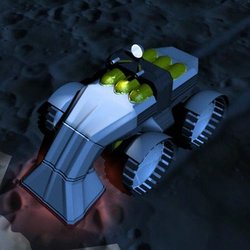
Artist illustration of a robotic ice miner. Image credit: NASA/John Frassanito & Associates. Click to enlarge
NASA’s new vision for space exploration hopes to send humans back to the Moon and then onto Mars over the next decades. The Chief Scientist for NASA’s Mars Program, David Beaty, has spent more than 20 years searching the Earth for metals and oil, and this makes the right man to help future astronauts survive off-Earth. Astronauts will become more like prospectors, searching the Moon and Mars for reserves of water to make air and rocket fuel. The more they can live off the land, the less they have to bring from Earth.
Long before David Beaty became associate Chief Scientist for NASA’s Mars Program, he was a prospector. Beaty spent 10 years surveying remote parts of Earth for precious metals and another 12 years hunting for oil.
And this qualifies him to work for NASA? Precisely.
Beaty has the kind of experience NASA needs as the agency prepares to implement the Vision for Space Exploration. “Mining and prospecting are going to be key skills for settlers on the Moon and Mars,” he explains. “We can send them air and water and fuel from Earth, but eventually, they’ll have to learn to live off the land, using local resources to meet their needs.”
On the Moon, for instance, mission planners hope to find water frozen in the dark recesses of polar craters. Water can be split into hydrogen for rocket fuel and oxygen for breathing. Water is also good for drinking and as a bonus it is one of the best known radiation shields. “In many ways,” notes Beaty, “water is key to a sustained human presence.” Ice mining on the Moon could become a big industry.
Beaty has learned a lot from his long career prospecting, exploring and mining on Earth. Now, with an eye on other worlds, he has distilled four pieces of wisdom he calls “Dave’s Postulates” for prospectors working anywhere in the solar system:
Postulate #1: “Wishful thinking is no substitute for scientific evidence.”
“On Earth, banks won’t lend money for less than proven reserves. From a bank’s viewpoint, anything less than proven is not really there. This lesson has been learned the hard way by many a prospector,” he laughs.
For NASA the stakes are higher than profit. The lives of astronauts could hang in the balance. “Proven reserves on the Moon can perhaps be thought of as having enough confidence to risk the lives of astronauts to go after it.”
What does it take to “prove” a reserve?that is, to know with confidence that a resource exists in high enough concentration to be produced?
“That depends on the nature of the deposit,” explains Beaty. “Searching for oil on Earth, you can drill one hole, measure the pressure and calculate how much oil is there. You know that oil probably exists 100 feet away because liquids flow. However, for gold you must drill holes 100 feet apart, and assay the concentration of gold every five feet down each hole. That’s because the solid earth is heterogenous. 100 feet away the rocks may be completely different.”
Deposits on the Moon aren’t so well understood. Is lunar ice widespread or patchy, deep or shallow? Does it even exist? “We don’t know,” says Beaty. “We still have a lot to learn.”
Postulate #2: “You cannot define a reserve without specifying how it can be extracted. If it can’t be mined, it’s of no use.” Enough said.
Postulate #3: “Perfect knowledge is not possible. Exploration costs money, and we can’t afford to buy all the information we want. We have to make choices, deciding what information is critical and what’s not.”
He offers the following hypothetical example:
“Suppose we decide to send a robot with a little drill and an onboard laboratory into Shackleton Crater, a place on the Moon with suspected ice deposits. We’re going to have to think pretty carefully about that lab. Maybe it can contain only two instruments. What are the two things we most need to know?”
“Suppose further that someone on Earth has invented a machine that can extract water from lunar soil. But it only works if the ice is close to the surface and if the ice is not too salty.” The choice is made. “We’d better equip the robot with instruments to measure the saltiness of the ice and its depth in the drill hole.”
Finally, Postulate #4: “Don’t underestimate the potential effects of heterogeneity. All parts of the Moon are not alike, just as all parts of Earth are not alike. So where you land matters.”
Ultimately, says Beaty, if geologists and engineers work together applying these rules as they go, living off the land on alien worlds might not be so hard after all.
Original Source: Science@NASA Article
Defending Against Radiation
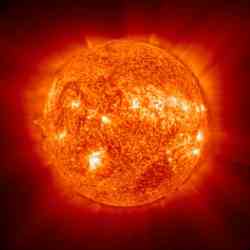
The sun is a major source of radiation for life on Earth. Image credit: NASA/ESA/SOHO. Click to enlarge
Space travel has its dangers. One of the biggest risks will come from the various types of radiation that flood space. Scientists are learning how life on Earth has evolved different kinds of tricks to resist radiation. Some animals and plants have evolved protective covering or pigmentation, but some forms of bacteria can actually repair damage to its DNA from radiation. Future space travelers might take advantage of these techniques to minimize the harm they get from long exposure.
In Star Wars and Star Trek movies, people travel between planets and galaxies with ease. But our future in space is far from assured. Issues of hyperdrive and wormholes aside, it doesn’t seem possible that the human body could withstand extended exposure to the harsh radiation of outer space.
Radiation comes from many sources. Light from the sun produces a range of wavelengths from long-wave infrared to short-wavelength ultraviolet (UV). Background radiation in space is composed of high-energy X-rays, gamma rays and cosmic rays, which all can play havoc with the cells in our bodies. Since such ionizing radiation easily penetrates spacecraft walls and spacesuits, astronauts today must limit their time in space. But being in outer space for even a short time greatly increases their odds of developing cancer, cataracts, and other radiation-related health problems.
To overcome this problem, we may find some useful tips in nature. Many organisms already have devised effective strategies to protect themselves from radiation.
Lynn Rothschild of the NASA Ames Research Center says that radiation has always been a danger for life on Earth, and so life had to find ways to cope with it. This was especially important during the Earth’s earliest years, when the ingredients for life were first coming together. Because our planet did not initially have much oxygen in the atmosphere, it also lacked an ozone (O3) layer to block out harmful radiation. This is one reason why many believe life originated underwater, since water can filter out the more damaging wavelengths of light.
Yet photosynthesis ? the transformation of sunlight into chemical energy ? developed relatively early in the history of life. Photosynthetic microbes like cyanobacteria were using sunlight to make food as early as 2.8 billion years ago (and possibly even earlier).
Early life therefore engaged in a delicate balancing act, learning how to use radiation for energy while protecting itself from the damage that radiation could cause. While sunlight is not as energetic as X-rays or gamma rays, the UV wavelengths are preferentially absorbed by DNA bases and by the aromatic amino acids of proteins. This absorption can damage cells and the delicate DNA strands that encode the instructions for life.
“The problem is, if you’re going to access solar radiation for photosynthesis, you’ve got to take the good with the bad — you’re also exposing yourself to the ultraviolet radiation,” says Rothschild. “So there’s various tricks that we think early life used, as life does today.”
Besides hiding under liquid water, life makes use of other natural UV radiation barriers such as ice, sand, rocks, and salt. As organisms continued to evolve, some were able to develop their own protective barriers such as pigmentation or a tough outer shell.
Thanks to photosynthetic organisms filling the atmosphere with oxygen (and thereby generating an ozone layer), most organisms on Earth today don’t need to contend with high energy UV-C rays, X-rays or gamma rays from space. In fact, the only organisms known to survive space exposure ? at least in the short term – are bacteria and lichen. Bacteria need some shielding so they won’t get fried by the UV, but lichen have enough biomass to act as a protective spacesuit.
But even with a good barrier in place, sometimes radiation damage does occur. The lichen and bacteria hibernate while in space ? they do not grow, reproduce, or engage in any of their normal living functions. Upon return to Earth, they exit this dormant state and, if there was damage inflicted, proteins in the cell work to piece together DNA strands that were broken apart by radiation.
The same damage control occurs with organisms on Earth when they’re exposed to radioactive materials such as uranium and radium. The bacterium Deinococcus radiodurans is the reigning champion when it comes to this sort of radiation repair. (Complete repair is not always possible, however, which is why radiation exposure can lead to genetic mutations or death.)
“I live in eternal hope of unseating D. radiodurans,” says Rothchild. Her search for radiation-resistant microorganisms has brought her to Paralana hot spring in Australia. Uranium-rich granite rocks emit gamma rays while lethal radon gas bubbles up from the hot water. Life in the spring is therefore exposed to high levels of radiation ? both below, from the radioactive materials, and above, from the intense UV light of the Australian sun.
Rothschild learned about the hot spring from Roberto Anitori of Macquarie University’s Australian Centre for Astrobiology. Anitori has been sequencing the 16S ribosomal RNA genes and culturing the bacteria that live quite happily in the radioactive waters. Like other organisms on Earth, the Paralana cyanobacteria and other microbes may have devised barriers to shield themselves from the radiation.
“I have noticed a tough, almost silicone-like layer on some of the microbial mats there,” says Anitori. “And when I say “silicon-like,” I mean the sort you use on window pane edging.”
“Apart from possible shielding mechanisms, I suspect that the microbes at Paralana also have good DNA repair mechanisms,” adds Anitori. At the moment, he can only speculate about the methods used by the Paralana organisms to survive. However, he does plan to closely investigate their radiation resistance strategies later this year.
In addition to Paralana, Rothschild’s investigations have brought her to extremely arid regions in Mexico and the Bolivian Andes. As it turns out, many organisms that evolved to live in deserts are also quite good at surviving radiation exposure.
Prolonged water loss can cause DNA damage, but some organisms have evolved efficient repair systems to combat this damage. It’s possible that these same dehydration repair systems are used when the organism needs to repair radiation-inflicted damage.
But such organisms may be able to avoid damage altogether simply by being dried out. The lack of water in desiccated, dormant cells makes them much less susceptible to the effects of ionizing radiation, which can harm cells by producing free radicals of water (hydroxyl or OH radical). Because free radicals have unpaired electrons, they eagerly try to interact with DNA, proteins, lipids in cell membranes, and anything else they can find. The resulting wreckage can lead to organelle failure, block cell division, or cause cell death.
Eliminating the water in human cells is probably not a practical solution for us to minimize our radiation exposure in space. Science fiction has long toyed with the idea of putting people into suspended animation for long space journeys, but turning humans into shriveled, dried-out raisins and then rehydrating them back to life isn’t medically possible – or very appealing. Even if we could develop such a procedure, once the human raisinettes were rehydrated they would again be susceptible to radiation damage.
Perhaps someday we can genetically engineer humans to have the same super radiation-repair systems as microorganisms like D. radiodurans. But even if such tinkering with the human genome was possible, those hardy organisms aren’t 100 percent resistant to radiation damage, so health problems would persist.
So of the three known mechanisms that life has devised to combat radiation damage – barriers, repair, and desiccation – the most immediately practical solution for human spaceflight would be to devise better radiation barriers. Anitori thinks his studies of the Paralana Spring organisms could someday help us engineer such barriers.
“Perhaps we will be taught by nature, mimicking some of the shielding mechanisms used by microbes,” he states.
And Rothschild says radiation studies also could provide some important lessons as we look toward establishing communities on the moon, Mars, and other planets.
“When we start to build human colonies, we’re going to take organisms with us. You’re ultimately going to want to grow plants, and possibly make an atmosphere on Mars and on the moon. We may not want to spend the effort and the money to protect them completely from the UV and cosmic radiation.”
In addition, says Rothschild, “humans are just full of microbes, and we couldn’t survive without them. We don’t know what effect the radiation will have on that associated community, and that may be more of a problem than the direct effect of radiation on the humans.”
She believes her studies also will be useful in the search for life on other worlds. Assuming that other organisms in the universe also are based on carbon and water, we can postulate what sort of extreme conditions they could survive in.
“Each time we find an organism on Earth that can live further and further into an environmental extreme, we’ve increased the size of that envelope of what we know life can survive within,” says Rothschild. “So if we go to a place on Mars that has a certain radiation flux, desiccation, and temperature, we can say, ‘There are organisms on Earth that can live under those conditions. There’s nothing that precludes life from living there.’ Now, whether life is there or not is another matter, but at least we can say this is the minimum envelope for life.”
For instance, Rothschild thinks life could be possible in the salt crusts on Mars, which are similar to salt crusts on Earth where organisms find shelter from solar UV. She also looks at life living under ice and snow on Earth, and wonders if organisms could live a comparatively radiation-protected existence under the ice of Jupiter’s moon Europa.
Original Source: NASA Astrobiology
Surgery in Space
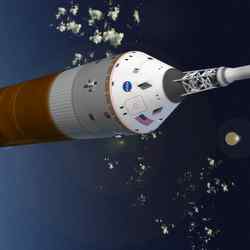
Surgery in space might be not that far away. Image credit: NASA Click to enlarge
If scientists can put a man on the moon, or send him into space for a few years at time, can they enable astronauts to perform complex surgical procedures there, too?
Professor Adam Dubrowksi of surgery doesn’t see why not, and he’s making space surgery a focus of his research. There’ll be a need for it once astronauts in the International Space Station begin to stay on board for extended periods, says Dubrowski, who is also a kinesiologist in the Surgical Skills Centre at Mount Sinai Hospital. The U.S. National Aeronautics and Space Administration (NASA) and the Canadian Space Agency (CSA) are also looking towards a mission to Mars, a journey that will take three to four years each way.
“The longer you stay, the more potential there is for things to happen,” Dubrowski points out, noting that lacerations and trauma injuries are certainly possible. Currently, astronauts get a few hours of medical training on the ground, which is insufficient for treating more serious injuries, he says. Although typically a medical doctor is on board the space station, “everybody has to know a bit of everything.” On longer missions, he anticipates having a physician and a highly skilled medical assistant who are both trained in surgery, while the rest of the crew will be trained in the basics.
Currently, emergencies are dealt with on board the space station and surgery can be performed using a remote-controlled robot. But as spaceships get further away from Earth, robotic surgery is no longer possible because the signals take longer to reach the mission, Dubrowski explains. And “no one understands what happens when you’re in zero gravity” and need to suture or staple a wounded person.
So Dubrowski, his wife, Waterloo kinesiology professor Heather Carnahan, and Dr. Gary Gray, a Canadian Space Agency consultant from Defence Research and Development Canada, hope to explore these questions with CSA funding. The three have already conducted zero-gravity research into basic motor skills such as touching one’s nose or tying one’s shoes. A weightless environment affects a person’s hand-eye co-ordination, aim and ability to apply a certain amount of force when undertaking tasks, he says. Dubrowski’s interest in space research began after he received his PhD in kinesiology in 2001 from the University of Waterloo. A native of Poland who immigrated to the Toronto area, Dubrowski was influenced by a visit to Dr. Otmar Bock, a leading German researcher in zero-gravity, following completion of his doctoral studies. The two maintained a collaboration, which helped Dubrowski get funding from the European Space Agency and the German Space Agency.
Now, the Canadian Space Agency plans to develop a surgery training protocol for astronauts and Dubrowski, Carnahan and Gray ? with the support of the experts from the Surgical Skills Centre and the Wilson Centre ? plan to bid for the contract. At the same time, they will be applying for smaller funds for parabolic flight research.
Space-surgery training will be three-pronged, Dubrowski explains. The first step is adaptation to zero gravity using an inverted paradigm in which experimental participants are placed upside down on something similar to a bed to “get more of an idea of weightlessness.”
The second step will be simulating zero gravity in a swimming pool; Dubrowski and Surgical Skills Centre manager Lisa Satterthwaite are working on procuring something similar to the huge swimming pool with the replica of the space station used in the NASA centre in Houston. “You can adjust the buoyancy of the person so they’re suspended in water,” Dubrowski says. “That’s another way of simulating zero gravity.”
Third, trainees will take their basic surgery skills on parabolic flights in which an airplane ascends and descends roughly 40 times, creating a transient zero-gravity environment on the descents. Dubrowski uses a variety of simple and complex simulators to allow students at the Surgical Skills Centre to practise skills such as stitching with skin patches.
Surgery in space isn’t that far away, Dubrowksi predicts; there are plans to put a manned lunar base on the moon in the next five to 10 years, which will necessitate better surgical skills for the longer missions. And the sooner the better, he says.
Original Source: U of T News Release
Self-Repairing Spacecraft
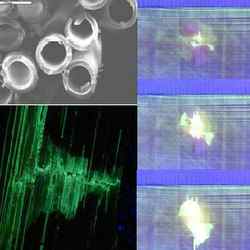
A time lapse sequence of self-repair taking place. Image credit: ESA Click to enlarge
Building spacecraft is a tough job. They are precision pieces of engineering that have to survive in the airless environment of space, where temperatures can swing from hundreds of degrees Celsius to hundreds of degree below zero in moments. Once a spacecraft is in orbit, engineers have virtually no chance of repairing anything that breaks. But what if a spacecraft could fix itself?
Thanks to a new study funded by ESA’s General Studies Programme, and carried out by the Department of Aerospace Engineering, University of Bristol, UK, engineers have taken a step towards that amazing possibility. They took their inspiration from nature.
“When we cut ourselves we don’t have to glue ourselves back together, instead we have a self-healing mechanism. Our blood hardens to form a protective seal for new skin to form underneath,” says Dr Christopher Semprimoschnig, a materials scientist at ESA’s European Space Technology Research Centre (ESTEC) in the Netherlands, who oversaw the study.
He imagined such cuts as analogous to the ‘wear-and-tear’ suffered by spacecraft. Extremes of temperature can cause small cracks to open in the superstructure, as can impacts by micrometeroids – small dust grains travelling at remarkable speeds of several kilometres per second. Over the lifetime of a mission the cracks build up, weakening the spacecraft until a catastrophic failure becomes inevitable.
The challenge for Semprimoschnig was to replicate the human process of healing small cracks before they can open up into anything more serious. He and the team at Bristol did it by replacing a few percent of the fibres running through a resinous composite material, similar to that used to make spacecraft components, with hollow fibres containing adhesive materials. Ironically, to make the material self-repairable, the hollow fibres had to be made of an easily breakable substance: glass. “When damage occurs, the fibres must break easily otherwise they cannot release the liquids to fill the cracks and perform the repair,” says Semprimoschnig.
In humans, the air chemically reacts with the blood, hardening it. In the airless environment of space, alternate mechanical veins have to be filled with liquid resin and a special hardener that leak out and mix when the fibres are broken. Both must be runny enough to fill the cracks quickly and harden before it evaporates.
“We have taken the first step but there is at least a decade to go before this technology finds its way onto a spacecraft,” says Semprimoschnig, who believes that larger scale tests are now needed.
The promise of self-healing spacecraft opens up the possibility of longer duration missions. The benefits are two-fold. Firstly, doubling the lifetime of a spacecraft in orbit around Earth would roughly halve the cost of the mission. Secondly, doubling spacecraft lifetimes means that mission planners could contemplate missions to far-away destinations in the Solar System that are currently too risky.
In short, self-healing spacecraft promise a new era of more reliable spacecraft, meaning more data for scientists and more reliable telecommunication possibilities for us all.
Original Source: ESA Portal
